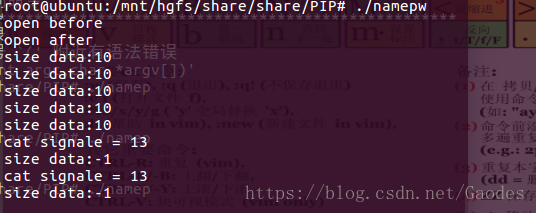管道的概念
管道是Unix中最古老的进程间通信的形式。 我们把从一个进程连接到另一个进程的一个数据流称为一个“管道” 我们通常把是把一个进程的输出连接或“管接”(经过管道来连接)到另一个进程的输入。
管道特点
管道是半双工的,数据只能向一个方向流动;需要双方通信时,需要建立起两个管道 只能用于父子进程或者兄弟进程之间(具有亲缘关系的进程)进行通信;通常,一个管道由一个进程创建,然后该进程调用fork,此后父、子进程之间就可应用该管道。
pipe函数
包含头文件<unistd.h> 功能:创建一无名管道 原型
int pipe(int file_descriptor[2]);
参数 file_descriptor:文件描述符数组,其中file_descriptor[0]表示读端,file_descriptor[1]表示写端 返回值:成功返回0,失败返回错误代码
示例代码:
#include<stdio.h>
#include<unistd.h>
#include<stdlib.h>
#include<signal.h>
#include<string.h>
int main(int argc,char *argv[])
{
int fd[2];
printf("f[0]=%d,f[1]=%d\n",fd[0],fd[1]);
pipe(fd);
printf("f[0]=%d,f[1]=%d\n",fd[0],fd[1]);
char buf[1024]={0};
int fid = fork();
if(fid > 0)
{
read(fd[0],buf,1024);
printf("read data %s\n",buf);
}
else if(fid == 0)
{
write(fd[1],"helloworld",strlen("helloworld"));
}
else
{
perror("fork error");
}
return 0;
}
打印结果

管道读写规则:如果试图从管道写端读取数据,或者向管道读端写入数据都将导致错误发生 当没有数据可读时,read调用就会阻塞,即进程暂停执行,一直等到有数据来到为止。 如果管道的另一端已经被关闭,也就是没有进程打开这个管道并向它写数据时,read调用就会阻塞
复制文件描述符dup
#include<stdio.h>
#include<stdlib.h>
#include<string.h>
#include<signal.h>
int main()
{
int fd = dup(1);
printf("file fd= %d\n",fd);
write(fd,"helloworld",strlen("helloworld"));
return 0;
}
打印结果:

1为输入到终端
shell管道的实现
原理通过把发的fd[1]写复制到shell的1(标准输入),fd[0]复制到shell的2(标准输出)
以下是代码:
#include<stdio.h>
#include<stdlib.h>
#include<fcntl.h>
#include<unistd.h>
#include<string.h>
#include<signal.h>
int main()
{
int fd[2];
char buf[1024] ={0};
pipe(fd);
int pid = fork();
if(pid > 0)
{
read(fd[0],buf,1024);
printf(buf);
}
else if(pid == 0)
{
dup2(fd[1],1);
close(fd[0]);
close(fd[1]);
execlp("ls","ls","-al",NULL);
}
else
{
}
return 0;
}
实现结果:

popen函数
作用:允许一个程序把另外一个程序当作一个新的进程来启 动,并能对它发送数据或接收数据
FILE* popen(const char *command, const char *open_mode);
command:待运行程序的名字和相应的参数 open_mode:必须是“r”或“w” 如果操作失败,popen会返回一个空指针
以下代码:
#include<stdio.h>
#include<stdlib.h>
#include<sys/types.h>
#include<sys/stat.h>
#include<fcntl.h>
#include<string.h>
int main()
{
FILE *file = popen("ls -al","r");
char buf[1024] = {0};
fread(buf,1,1024,file);
fclose(file);
FILE *wcfile = popen("wc","w");
fwrite(buf,1,strlen(buf),wcfile);
fclose(wcfile);
return 0;
}
代码结果:
![]()
命名管道破裂测试
我们首先要知道命名管道,要读段和写段同时开启,才能向文件读写数据。
贴上代码来理解命名管道的规则
首先是读端:
#include<stdio.h>
#include<unistd.h>
#include<stdlib.h>
#include<signal.h>
#include<string.h>
#include<fcntl.h>
int main(int argc,char *argv[])
{
printf("open before\n");
int fd = open("/home/gao/tmp/fifo",O_RDONLY);
printf("open after\n");
//休眠5秒,读端退出
sleep(5);
return 0;
}
接下来是写端:
#include<stdio.h>
#include<unistd.h>
#include<stdlib.h>
#include<signal.h>
#include<string.h>
#include<fcntl.h>
void handle(int signo)
{
printf("cat signale = %d\n",signo);
}
int main(int argc,char *argv[])
{
signal(SIGPIPE,handle);
printf("open before\n");
int fd = open("/home/gao/tmp/fifo",O_WRONLY);
printf("open after\n");
//命名管道规则,如果写入读断被中断,写入会返回-1,并且管道会破裂,产生信号(SIGPIPE)
while(1)
{
int wrsize = write(fd,"helloworld",strlen("helloworld"));
printf("size data:%d\n",wrsize);
sleep(1);
}
}
执行写端:

它在等待另一端的开启,才能向里面写入数据
此时我们开启读端:
![]()
马上可以看到写段可以写数据

而执行5秒后,我们可以看到写的时候返回-1,并且获取到管道破裂的信息(SIGPIPE)
所以这里就是我们所注意的点,当我们写客户端和服务器进行管道传输的时候,如果客户端一旦退出来,就会使管道破裂,所以我们必须通过捕捉信号,来避免这种事情发生。
 深入理解Unix管道通信
深入理解Unix管道通信





















 1942
1942

 被折叠的 条评论
为什么被折叠?
被折叠的 条评论
为什么被折叠?








